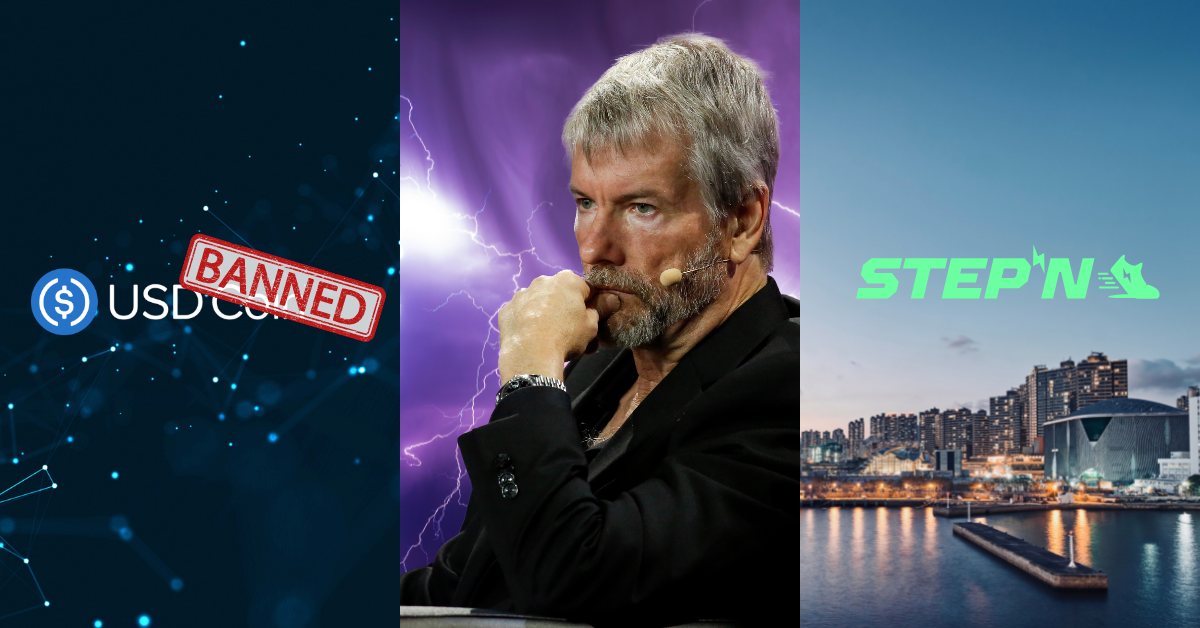In this issue
- USDC: Ousted
- MicroStrategy: Macro plans
- STEPN: Hello, Hong Kong
From the Editor’s Desk
Dear Reader,
“Survival of the fittest” is a creed that appears to have found favor at Binance this week. Or, perhaps, “survival of the most powerful,” which seems to be the real message coming from the world’s largest cryptocurrency exchange.
Binance’s move to toss USD Coin (USDC) off its platform is a bold gambit to boost the fortunes of its own stablecoin, Binance USD (BUSD) — the third-biggest stablecoin by market cap, following USDC in second place and Tether in the top spot. And the fact that it comes amid reports that Binance is undercutting the fees charged by its main exchange rival, Coinbase — the second-largest crypto exchange in the business — suggests that Binance is making a concerted push for next-level dominance of the crypto space.
If some of this feels familiar, look no further than Google, a company whose control of the search engine market is so complete that it’s unremarkable to anyone that its name is also now a verb.
A decade ago, U.S. Federal Trade Commission officials concluded that Google had engaged in anticompetitive practices and abused its monopoly power in a way that harmed both rival businesses and the interests of internet users. The officials’ recommendation to sue Google was, however, dropped by the commission’s leadership, and their report was buried, only to surface accidentally three years later.
Google may have gotten off the hook, yet one might wonder whether antitrust authorities at the commission and elsewhere could now start looking at Binance as closely as they once looked at the world’s dominant search engine.
The crypto space may still be relatively unregulated in terms of its financial mechanisms, but regulation around competition is well established, proven effective, and enforced constantly. Amid such strong-arm tactics as we’ve seen from Binance this week, the bigger point is who has ultimate control over the choices consumers have. In this case, is Binance’s move counter to the decentralized ideals of individual control and choice?
The rules of engagement should still apply if free and competitive markets are felt to be at risk of potential monopolization.
And beyond that, perhaps an even greater potential foul is the way in which Binance’s move might reflect on the industry more broadly. It’s one thing to provide incentives and a market for people to use your stablecoin in preference to those of rivals, but it’s quite another to do so in such a forced fashion and with nary a word to those same people in the first place.
In a sector as young as this one, the behavior of just one player can have a disproportionate effect on the entire market. There’s plenty of real estate in crypto for fair competition that spreads the benefits of this always-innovating industry.
Until the next time,
Angie Lau,
Founder and Editor-in-Chief
Forkast
1. USDC non grata

By the numbers: USDC — over 5,000% increase in Google search volume.
Binance, the world’s biggest crypto exchange by trading volume, has announced that it would effectively banish USD Coin (USDC), the world’s second-largest stablecoin, from its platform as stablecoin competition heats up.
- Binance will convert its existing users’ balances and new deposits of USDC into the company’s own stablecoin, Binance USD (BUSD), starting from Sept. 29, according to an announcement this week. Binance will do the same with user balances and new deposits of two other stablecoins, Pax Dollar (USDP) and True USD (TUSD). Binance will cease the trading of the three stablecoins on its platform on Sept. 26.
- Binance users can also convert their USDC, USDP or TUSD balances to BUSD manually at a 1:1 ratio before they are automatically converted. Following automatic conversion, users will be able to withdraw the three stablecoins at a 1:1 ratio from their BUSD balances.
- USDC, issued by Circle Internet Financial in 2018, is the world’s second-largest stablecoin, with a market cap of more than US$51 billion, according to CoinMarketCap. Binance’s BUSD, the third-largest stablecoin, trails it with a market cap of around US$19 billion.
- Binance’s move may hinder USDC’s momentum against its stablecoin rivals. USDC’s market cap was US$51.7 billion at press time, down by around just 0.15% from its level in the days leading up to and immediately following Binance’s announcement, according to CoinMarketCap.
Forkast.Insights | What does it mean?
Binance has never shied away from taking bold steps to boost its own products. When it announced a launchpad to bootstrap crypto startups, investors looking to back early-stage projects had to buy Binance token BNB. That was the catalyst that propelled BNB to 1,300% growth last year and become the world’s third-largest cryptocurrency (it has since slipped back to being the fifth-largest).
But this week’s move to forcibly convert all holdings of a rival stablecoin in favor of its own coin is unprecedented. USDC has become increasingly powerful as it has positioned itself as the on-ramp for institutional investors looking to dabble in crypto markets.
USDC is regulated in the U.S., and it has made significant inroads into the offerance of treasury services for startups, capitalizing on emerging financial infrastructure. These factors have allowed USDC to leapfrog over both BNB and BUSD in the market cap rankings, and many market observers believe it could overtake Tether. Binance’s response speaks for itself.
Binance may be the world’s largest crypto exchange by volume, but USDC will likely survive its eviction just fine, even if a bit bruised. However, for smaller projects on Binance’s platform, the exchange’s sudden ejection of rival coins should be cause for wariness and concern.
2. Summoning Lightning

By the numbers: MicroStrategy — over 5,000% increase in Google search volume.
Former MicroStrategy Chief Executive Michael Saylor doubles down on Bitcoin, saying that MicroStrategy is developing new applications to onboard large numbers of BTC users to the Lightning Network.
- During last weekend’s Baltic Honeybadger 2022 conference, Saylor said MicroStrategy is looking to expand the applications of the Lightning Network, with research and development projects involving an enterprise Lightning wallet, enterprise Lightning servers and enterprise authentication.
- Having long been a supporter of the Lightning Protocol and a Bitcoin maximalist, Saylor told the meeting the Lightning Network — a layer-2 payment protocol on top of Bitcoin to enable cheap, fast Bitcoin transactions — was “the most important thing going on in the world in technology.”
- MicroStrategy, a U.S.-based enterprise software company, is the largest corporate holder of Bitcoin, holding an estimated 129,698 BTC (approximately US$2.5 billion of the crypto), according to BitcoinTreasuries. The company bought another 480 BTC in late June amid sliding crypto prices.
- MicroStrategy announced in early August that Saylor would step down as chief executive and become executive chairman, leading the company’s Bitcoin acquisition and allowing it to split its focus between two corporate strategies: growing its enterprise software business and activities related to Bitcoin.
- MicroStrategy’s decision to boost the adoption of the Lightning Network comes as the crypto market struggles with low prices. Bitcoin has been languishing below US$20,000 recently, having broken that psychological threshold only intermittently since late August, according to CoinMarketCap.
- Apart from being buffeted by Crypto Winter, Saylor is also embroiled in legal problems. He has been sued by the District of Columbia in a tax fraud case involving the alleged non-payment of taxes totaling more than US$25 million. MicroStrategy is also accused of helping him misstate his residential address to avoid paying those taxes.
Forkast.Insights | What does it mean?
The Lightning Network has long been held out as Bitcoin’s great hope, even though the network has made few gains in its utility, choosing instead to remain doggedly loyal to the original cryptocurrency created by its pseudonymous creator Satoshi Nakamoto.
Lightning is an attempt to modernize Bitcoin by taking transactions off the Bitcoin network and using the Bitcoin blockchain only as a settlement layer when two parties have completed transacting with one another. It’s a nice idea in theory, but it has created an overly-complex network that is prone to failures.
Saylor’s cheerleading for Lightning will no doubt be a boon for diehard believers in the technology, but the reality is that Bitcoin’s role as the foundation for crypto transactions is changing. Tether now handles the bulk of daily volume, and BTC’s market cap as a percentage of the total asset class has been in decline for the last three years.
Saylor is known for being bullish on Bitcoin, and he has bet his company’s fortunes on it. That doesn’t mean everyone else should.
3. STEPN to a fragrant harbor

Web3 move-to-earn app STEPN is setting up an office at Hong Kong’s Cyberport business park, despite concerns over the city’s planned licensing regime for digital asset companies and its still-draconian Covid-19 control measures, according to the South China Morning Post.
- STEPN co-founder Jerry Huang said the company would open its first physical office at Cyberport, making Hong Kong its first regional headquarters outside Australia.
- STEPN is a Solana-based move-to-earn app through which users can earn cryptocurrency by walking, jogging or cycling after buying non-fungible token (NFT) sneakers and holding them in wallets on their phones. The company last month announced a collaboration with Spanish soccer club Atlético de Madrid and crypto exchange WhaleFin to launch NFT running shoe collections.
- STEPN decided to make its move following a visit from former Cyberport Chairman George Lam, who traveled to Australia to invite the company to help Hong Kong create a Web3 startup environment.
- STEPN’s move swims against an exodus of crypto companies from Hong Kong, chilled by the territory’s proposed introduction of a licensing regime for virtual asset businesses, the shadows of mainland China’s crackdowns on crypto, and burdens of the government’s pandemic-era rules on travel and everyday life, which are still among the most onerous in the world. Among those who left Hong Kong is crypto exchange FTX, which last year moved its headquarters to the Bahamas.
- Despite Hong Kong’s struggles, the territory remains a global finance center and still aims to develop itself as a digital assets hub. Hong Kong was home to more than 600 fintech companies last year, 10% of which were in the digital asset sector and 7% of which were involved in blockchain, according to government data. Hong Kong is currently hosting Digital Asset Series seminars, which started in August and will continue into November, to educate the general public about the evolving digital asset landscape.
- Lam’s successful courtship of STEPN also comes against a backdrop of the city losing its shine following crackdowns on its pro-democracy movement, the imprisonment of many of its most prominent opposition leaders, and the enactment of a national security law that has severely curtailed press freedom, people’s right to free speech and other civil liberties.
- STEPN, which had over 700,000 active monthly users in May this year, has seen big declines in its user base since, to fewer than 140,000 in August, according to Dune Analytics.
Forkast.Insights | What does it mean?
STEPN has been busting some bold moves lately. In May, the move-to-earn app said it was banning itself in mainland China and ceasing to provide Global Positioning System and internet protocol location services to users in the country from mid-July. The company said it had never engaged in any business on the Chinese mainland and that its withdrawal came in response to a need to abide by Chinese regulations.
Now, STEPN is jumping into Hong Kong despite a looming licensing regime for virtual asset service providers. The company also appears unswayed by Hong Kong’s increasingly repressive political environment and still-harsh Covid-19 restrictions that have prompted a brain drain and young families leaving the city en masse.
STEPN’s decision to set up shop in Hong Kong at Cyberport, a glitzy government-owned business-incubator office complex, shows that the city is still attractive to some companies if there are enough incentives. Cyberport houses around 800 startups, including blockchain companies like Animoca Brands, which in May last year emerged as its fifth unicorn, according to the business park’s 2020-2021 annual report.
Launched just over a year ago, STEPN saw its native currency, Green Satoshi Token, plunge from an all-time high of US$9.03 in late April to around US$0.20 in mid-June amid the protracted crypto market slump. GST has been changing hands at around US$0.03 over the past week, according to data from CoinMarketCap.
To create a new revenue stream, STEPN set up its own decentralized exchange, DOOAR, in July. In the second quarter of the year, STEPN said it generated a profit of US$122.5 million through its platform fees, following only around US$26.8 million in the first quarter.
STEPN’s leap into Hong Kong has landed the company in the spotlight again. Is it a desperate last dance by a fading star — or will the big move allow the company a fresh start and shake off its doldrums? Only time will tell how the audience will respond.




